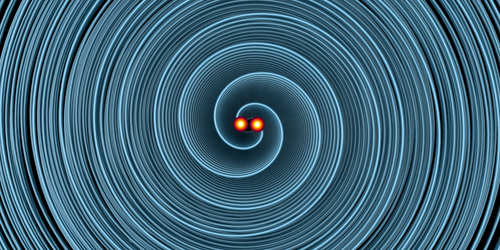Black Holes Obey Information-Emission Limits
The extreme nature of black holes means that they offer unique opportunities for testing the limits of physics laws. One law that researchers have wanted to test in this way is the one describing the maximum rate at which information can flow out from a system. But until recently, this test was impossible with black holes because of a lack of suitable candidates. That changed with the first measurements of gravitational waves. Now, an analysis of the gravitational waves detected from eight black hole mergers confirms that the law applies to these extreme objects [1].
Any perturbed object will emit information about its state until it returns to equilibrium. Theory predicts a limit to the rate of this information emission, with that limit depending on the object’s temperature and its relaxation time (how fast it regains equilibrium). For freshly merged black holes, these parameters are encoded in the emitted gravitational waves.
Of the roughly 50 black hole mergers so-far detected, researchers from the University of Pisa, Italy, and the University of Glasgow, UK, selected eight from which they could make confident measurements of relaxation times. For each of these mergers, the team calculated the maximum average rate of information emission per unit of energy. They found that these rates are the fastest for any known object: about bits per second per joule, or 75% of the theoretical maximum. At this extreme rate, perturbed black holes broadcast information at a rate roughly 11 orders of magnitude higher than those involving “everyday” room-temperature objects that are roughly a meter wide.
The result confirms that black holes obey fundamental principles of general relativity, information theory, and thermodynamics—a finding that the team says wasn’t guaranteed to be true. Any future extensions to general relativity, they say, must obey this information bound as well.
–Christopher Crockett
Christopher Crockett is a freelance writer based in Arlington, Virginia.
References
- G. Carullo et al., “Bekenstein-Hod universal bound on information emission rate is obeyed by LIGO-Virgo binary black hole remnants,” Phys. Rev. Lett. 126, 161102 (2021).




